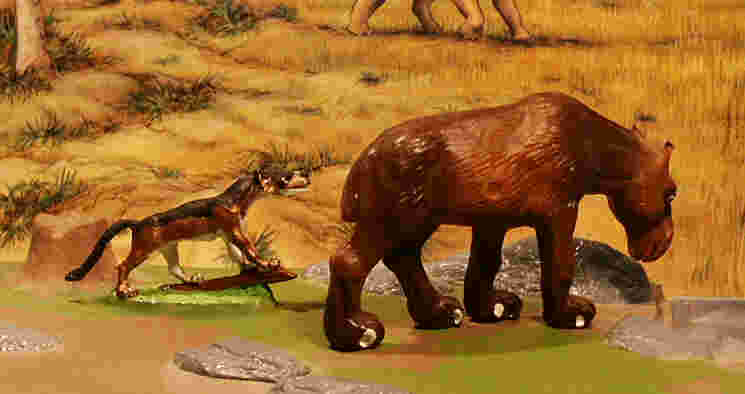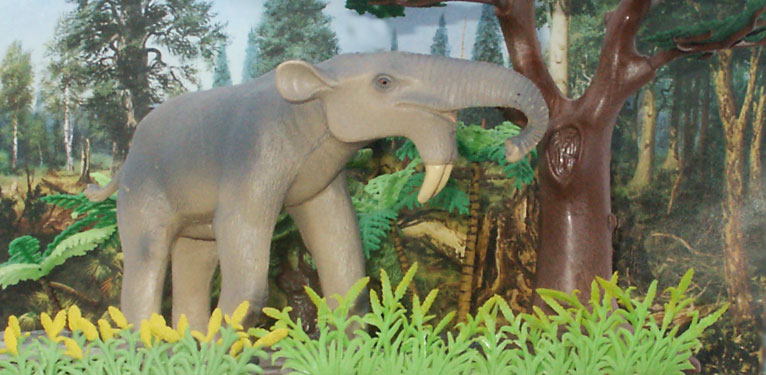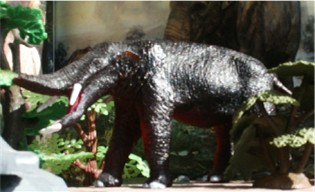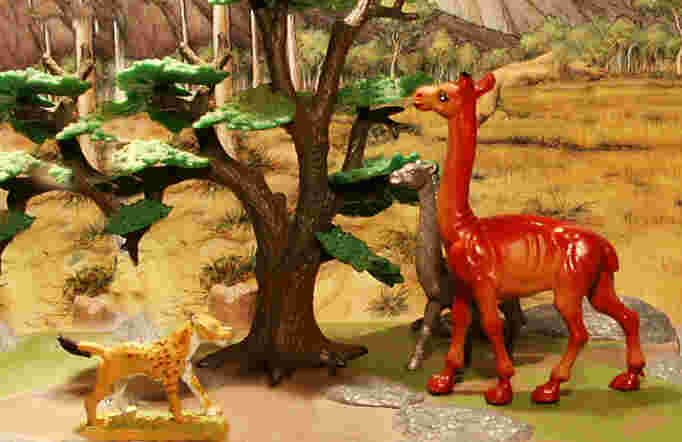
The Dinosaur Collector
The Miocene,
5.32 to 23.8 million years ago, was a time of warmer global climates than those in the preceding Oligocene, or the following Pliocene. The animals families evolving dominate the the fauna until the Pleistocene.
update 10/1/08
Moropus (sloth foot) lived during the early Miocene epoch was found in North America, Europe, Asia and Africa. It belonged to an ancient herbivore group called the chalicotheres. They were Perissodactyl (odd-toed) mammals the group that includes rhinos, horses and tapirs. Chalicotheres are divided into two groups the knuckle walkers and those like Moropus who walked flat footed. They probably did not live in large groups. Although not numerous Chalicotheres survived until the last Ice Age or perhaps longer. Some Siberian tomb painting contain an animal that looks much like a Chalicothere. Amphicyonid bear dogs ranged from small and dog-like to very large and more like bears in Asia and North America. They ranged the grasslands of Asia and North America dying out before the end of the Miocene.

Starlux Mororpus and Ral Patha amphicyonid Daphoenus. The Daphoenus figure looks a little too dog like and might be a better match for Hemicyodon as seem in the The Simon and Schuster Encyclopedia of Dinosaurs and Prehistoric Creatures. Most reconstructions have Daphoenus looking more bearish.
Archaeotherium lived in
from the Early Oligocene to Early Miocene North Dakota, South Dakota,
Nebraska, and Wyoming. This pig like animals was omnivorous and it thought
to have cached food for later use. Camels were on the menu. |
Daeodon formerly Dinohyus (terrible pig) was about the size of a bull the last of the entelodonts. Fossil teeth found fit the bite marks found on the bones of Moropus. While scavenging is the most likely explanation active predation can't be ruled out for the large aggressive omnivores | |
|
 |
|
| From Royal Saskatchewan Museum in Regina, Saskatchewan diorama. Picture by Sean Bell. | Dinohyus from the Nabisco premium series made by Lido. These are custom painted the originals came in either silver or gold. Recasts used in gumball machines came in a variety of colors. |
Deinotherium (terrible beast) had downwards pointing tusks that seem to have been used for stripping tree bark. Extinct genus of elephant like mammals. Tusks were developed from the lower jaw instead of the upper as in modern elephants. The skull was more primitive, and its size is much larger, than in the living elephant. Deinotheres have been found in the Miocene and early Pliocene strata of Europe and Asia. The last of them linger on into the Pleistocene of Africa.

Deinotherium from Bullyland.
Gomphotherium was a 4-tusked,
primitive mastodont that was about 10 ft (3 m) tall. This plant-eater
mammal lived during the early Miocene until the early Pliocene.
It lived in Africa, North America, Asia and Europe. It is seen as
the ancestor to mastodons, mammoths and modern elephants. Gompotherium
seems to have shared the savannah habitats with the larger Deinotherium
so perhaps they had different feeding styles. |
Platybelodon in Europe
and Asia and it's close relatives in North America developed specialized
feeding strategy in the Late Miocene. The shovel tuskers suffered
the fate common to specialist and became extinct relatively quickly. Masodonts
die out in North America in the Early Pleistocene as the mammoths arrive
from Asia. |
|
 |
 |
|
Bullyland Gomphotherium. |
Platybelodon in resin
by Salas donated by Alchemy works. |
| Osteoborus first appeared during the late Miocene epoch (about 8 million years ago), and became extinct around 1.5 million years ago during the Pleistocene epoch. It was a family of primitive dogs with robust, conical teeth quite similar to those of hyenas. This kind of dentition is an adaptation to crushing bones. Aepycamelus sports a very long neck, looking much like a giraffe and inspiring an earlier name of Alticamelus (Tall Camel). Camels were a much more varied group that today's survivors. They had not yet become specialized to desert environments or humps. | The long necked camel, Alticamalus eyeballs his environment. These animals normally travel in small herds but this is a solitary specimen. He enjoys plucking juicy leaves from the trees. Camels in North America are diverse and successful eventually spreading to South America. They begin to decline in the Early Pleistocene and become extinct in North America with most of the mega fauna. |
|
 |
|
|
Osteoborus from Ral
Partha, Aepycamelus from Starlux and Nabisco |
Riff's Lost World Starlux
Alticamalus. Custom diorama submitted
by Riff Smith photo by Bob. |
Return to Cenozoic menu
 Click on the Site A icon to the right for Dioramas organized by period or by
manufacturer.
Click on the Site A icon to the right for Dioramas organized by period or by
manufacturer.